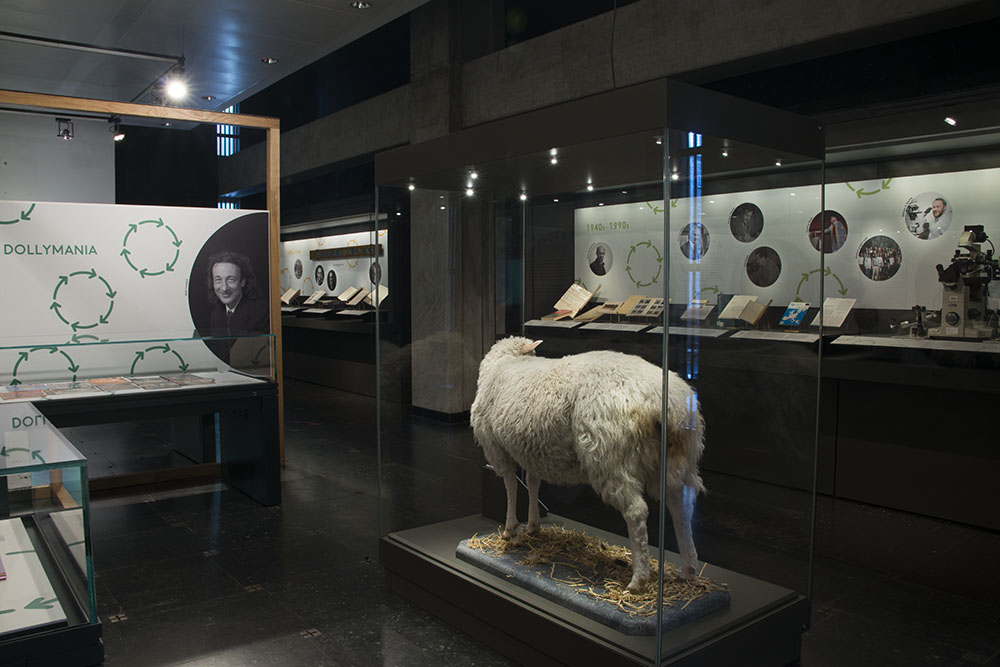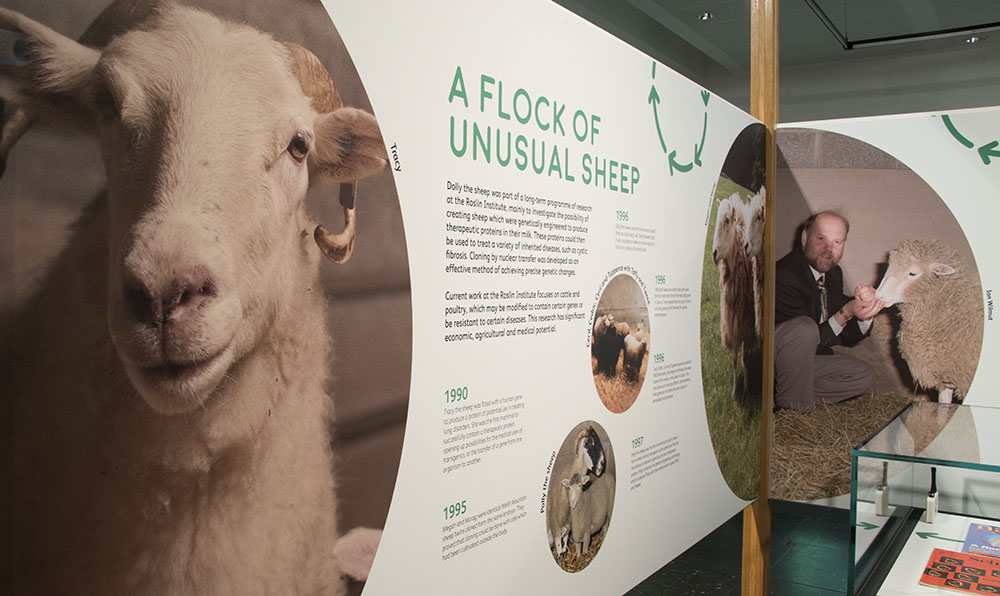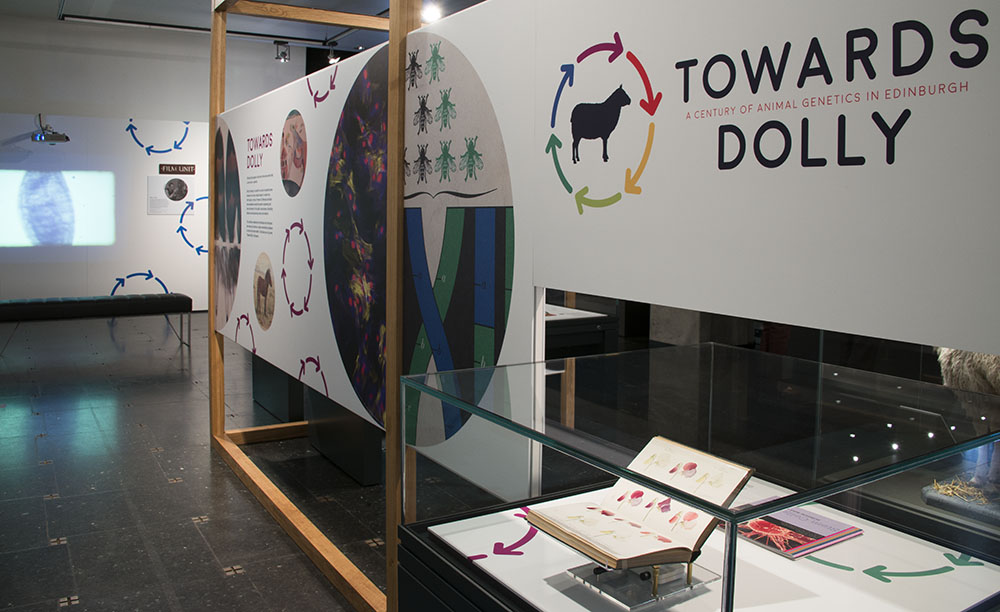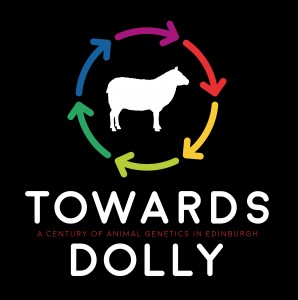12 days ago, the doors of Edinburgh University’s Main Library Exhibition Gallery opened on ‘Towards Dolly: a century of animal genetics in Edinburgh’. This exhibition has given us the chance to display Dolly the sheep, on loan from National Museums Scotland, while her new home in their redesigned Science and Technology Gallery is being prepared. But it has also allowed us to show some of the collections which have been catalogued over the last three years as part of the Wellcome Trust-funded ‘Towards Dolly’, ‘Making of Dolly’ and ‘Science on a Plate’ projects, which tell the story of animal genetics in Edinburgh over the last 100 years. We’ve also been able to feature the microscope which cloned Dolly (on loan from the Roslin Institute), DNA models on loan from the School of Biological Sciences, books from the Noreen and Kenneth Murray Library and the Main Library’s general holdings, and animal skulls from the University’s Anatomical Museum. Together, these varied items represent the richness of the University’s collections, the diversity of Edinburgh’s genetics history, and the generosity of our colleagues in helping us source the perfect exhibits.
 Working together with our designers Studio SP and CRC Exhibitions Officer Emma Smith, we decided to take a chronological approach, beginning with James Cossar Ewart’s early zebra and horse cross-breeding work in Penicuik and ending by looking at cutting-edge stem research taking place in the University’s MRC Centre for Regenerative Medicine. We aimed to represent just some of the many animal breeding and genetics organisations which have existed and intersected over the decades: the Institute of Animal Genetics, the Animal Breeding Research Organisation, the Poultry Research Centre, the Institute of Animal Physiology and Genetics Research and the Roslin Institute. We also highlight outstanding work by particular individuals, such as Charlotte Auerbach’s work on mustard gas with J.M. Robson during World War Two and Douglas Falconer’s landmark textbook Introduction to Quantitative Genetics.
Working together with our designers Studio SP and CRC Exhibitions Officer Emma Smith, we decided to take a chronological approach, beginning with James Cossar Ewart’s early zebra and horse cross-breeding work in Penicuik and ending by looking at cutting-edge stem research taking place in the University’s MRC Centre for Regenerative Medicine. We aimed to represent just some of the many animal breeding and genetics organisations which have existed and intersected over the decades: the Institute of Animal Genetics, the Animal Breeding Research Organisation, the Poultry Research Centre, the Institute of Animal Physiology and Genetics Research and the Roslin Institute. We also highlight outstanding work by particular individuals, such as Charlotte Auerbach’s work on mustard gas with J.M. Robson during World War Two and Douglas Falconer’s landmark textbook Introduction to Quantitative Genetics.
Dolly stands proudly in her own case, and already staff and members of the public are enjoying getting up close to her eyeline and even sharing their ‘Dolly selfies’ on social media! An informational panel behind Dolly’s case tells the story of the other groundbreaking sheep at Roslin: from Tracy the transgenic sheep, who contained a human gene for a therapeutic protein to potentially treat lung disorders, to Megan and Morag, the twin sheep who made Dolly possible, to Polly the sheep and her siblings, who were cloned and transgenic at the same time.
As well as physical exhibits, there is pioneering filmmaker Eric Lucey’s film of the developing egg of the fruit fly Drosophila – this fly has played a hugely important role in the history of genetics, as we also explore in a case in the external entrance area to the exhibition (pictured above). In addition, audio clips of scientists talking about their work are available for visitors to hear on their smartphones via the IZI Travel app or any QR code reader; from Ian Wilmut recalling the reaction of the public, media and government to Dolly’s birth to Institute of Animal Genetics staff singing comedy genetics songs!
It has been good to hear positive responses to the exhibition from current and retired scientists as well as the family of many individuals we have featured. The exhibition was recently selected as one of ThreeWeeks magazine’s ’81 recommended shows’ to see during the Edinburgh Festival. If you haven’t already, do come along, take a look, and tell us what you think!
‘Towards Dolly: a century of animal genetics in Edinburgh’ is free and open to the public 10:00-17.00 Monday to Saturday, at the Main Library Exhibition Gallery, George Square, from 31 July-31 October 2015.
https://exhibitions.ed.ac.uk/towardsdolly
#towardsdolly
Clare Button
Project Archivist






D.S.Falconer’s book is titled “Introduction to Quantitative Genetics”. NOT “An Introduction…Genetics.
Thanks for picking up on this Nallappagounder – I will make the correction!
A nice post about the exhibition. Hope many will come to view it – it is so worthwhile. Congratulations also to the archive team for al their excellent and painstaking work. Looking for lots more goodies to come and, not surprisingly coming from me, hopefully more about ABRO.
Many thanks indeed Gerald for your kind words and support with the project and the exhibition. Don’t worry, a blog post or two about ABRO is certainly forthcoming! All the very best, Clare